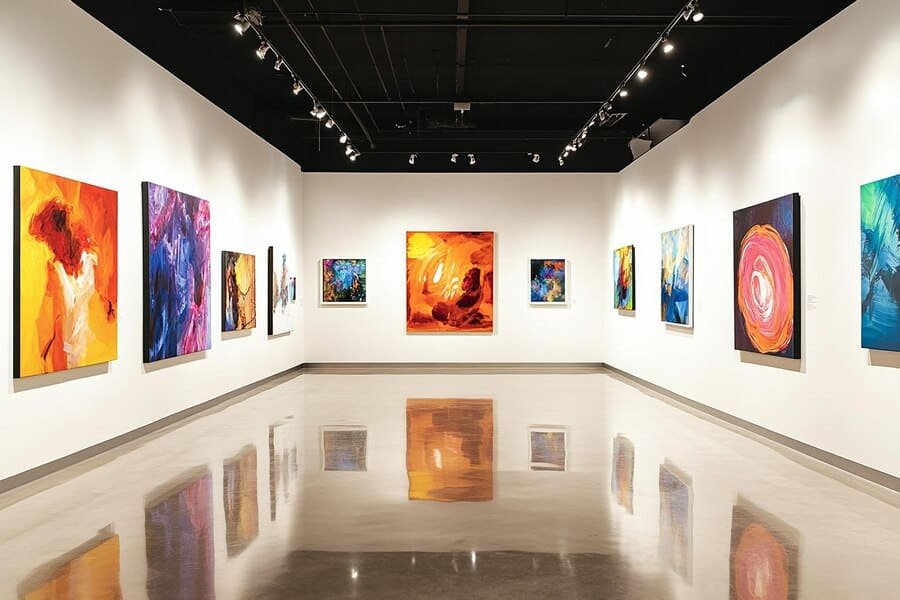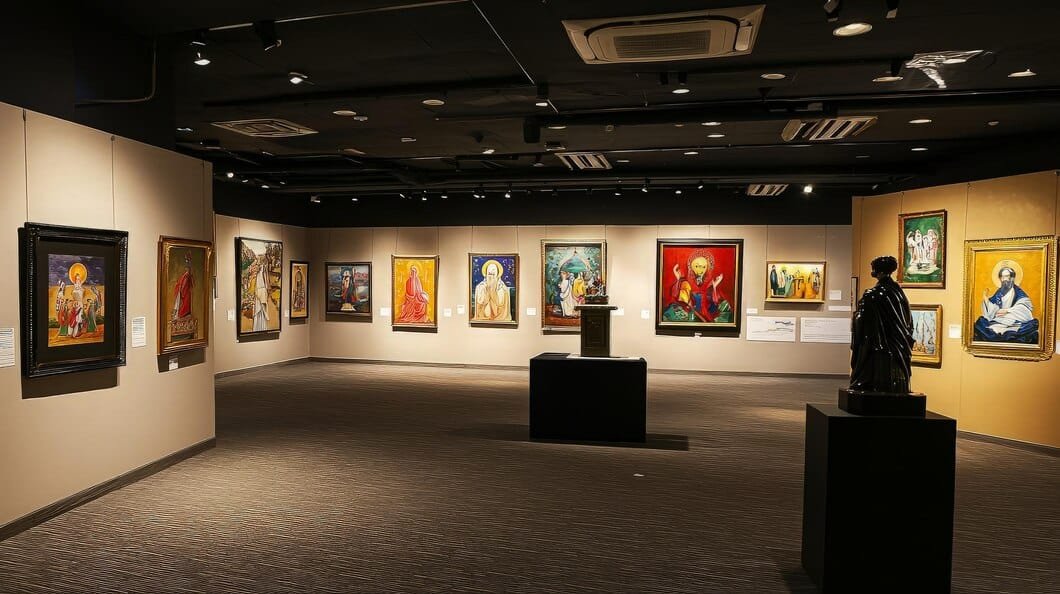Creating an arts exhibition that grabs the audience’s attention is a unique skill. It involves picking the right artwork and designing experiences that pull people in. The curator’s job is key in making this happen, connecting viewers with the art in a meaningful way. This guide is for anyone looking to create an engaging arts exhibition, whether you’re new to the field or have experience.
Key Takeaways
- Understand the importance of balancing artistic knowledge and effective communication in curating a successful exhibition.
- Recognize the curator’s role as a guide, leading visitors through a thoughtful and immersive journey.
- Prioritize inclusive design and accessibility to create an exhibition that resonates with diverse audiences.
- Embrace the responsibility of challenging traditional museum practices and addressing biases.
- Focus on substance over spectacle, ensuring the exhibition’s content and themes take precedence.
The Essence of Curating: Balancing Knowledge and Communication
At the heart of a great arts exhibition is a balance. It’s about sharing knowledge and making it clear to visitors. Curators, the keepers of this balance, guide people through contemporary art and visual arts.
The Caravan of Knowledge: Curators as Guides
Curators tell stories that bring artistic expression to life in cultural institutions or arts organizations. They lead visitors through museums or galleries. They share art history and curatorial insights that make the visitor experience richer.
Crafting Memorable Experiences: Feeding the Soul
Curating is more than just showing art; it’s about creating lasting memories. Curators use exhibition design, interpretive strategies, and audience engagement to make sure the exhibition texts and artist’s voice touch hearts. This builds a true love for art appreciation.
“Curating is not just about arranging objects, but about creating experiences that captivate the senses and ignite the imagination.”
By finding the right mix of knowledge and communication, curators make the visitor experience special. They turn an exhibition into a deep dive into the human spirit through artistic expression.
Inclusive Design: Embracing Diversity and Accessibility

In curating arts exhibitions, inclusive design is key. Curators need to rethink museum practices that have left out some communities. They should highlight underrepresented artists to make exhibitions welcoming to everyone.
This approach ensures that all visitors feel included. It promotes diversity and accessibility. This way, exhibitions truly reflect our diverse world.
Questioning Museum Practices: Challenging Defaults and Supremacies
Curators must question the curatorial ethics and social responsibility in the industry. They should look at how defaults and supremacies have limited marginalized communities in exhibitions. By using universal design and ensuring disability inclusion, they can make exhibitions accessible to all.
| Inclusive Design Practices | Traditional Museum Practices |
|---|---|
| Prioritize accessibility features, such as audio descriptions, braille labels, and wheelchair-friendly layouts. | Rely on visual displays and written text as the primary means of communication. |
| Actively seek out and showcase the work of underrepresented artists from marginalized communities. | Predominantly feature work by established, mainstream artists. |
| Organize educational programs and workshops that cater to diverse learning styles and abilities. | Offer one-size-fits-all educational programming. |
By adopting inclusive design, curators can showcase the full range of human diversity and representation. This change improves the visitor experience. It also makes the arts world more just and socially responsible.
Overcoming Prejudices: Opening Conversations and Taking Responsibility

In the world of curating arts exhibitions, it’s key for professionals to face their own curatorial prejudices and biases. As the keepers of cultural stories, curators play a big role in fighting for social justice. They must also work to make sure everyone is seen and heard through inclusive practices.
Curators need to start by recognizing their own biases. They should be ready to have real talks and think deeply about how their own biases have shaped the stories told in museums. This step is crucial for changing museums for the better and making curating more ethical.
- Embrace open conversations around curatorial prejudices and biases
- Actively seek to diversify narratives and amplify marginalized perspectives
- Challenge the defaults and supremacies ingrained in traditional museum practices
- Cultivate a culture of self-reflection and accountability within the curatorial field
By owning up to their part in unfair practices, curators can help make arts exhibitions more inclusive and socially just. This change in thinking is vital for curators to do their job right. They must care for cultural heritage and help museums change for the better.
“Curators must be willing to engage in honest self-reflection and openly address the ways in which their own biases have historically shaped the narratives and representation within arts institutions.”
| Addressing Biases | Diversifying Narratives | Institutional Change |
|---|---|---|
| Acknowledging the existence of curatorial prejudices | Amplifying marginalized perspectives | Cultivating a culture of self-reflection and accountability |
| Engaging in honest self-reflection | Challenging defaults and supremacies in museum practices | Fostering more ethical curating practices |
| Taking responsibility for biased practices | Diversifying the narratives represented | Driving institutional transformation |
Avoiding Gimmicks: Prioritizing Substance over Spectacle

In today’s arts world, curators face a big challenge. They must stick to curatorial integrity and focus on substance over spectacle. The real power of an exhibition comes from meaningful content and connecting with the audience on an emotional level.
The Emergence of Diverse Talent: Speaking to the Soul
A new trend is changing the art scene. Diverse talent is speaking to people’s souls. These marginalized artists and underrepresented perspectives are shaking things up. They offer a fresh view, away from the usual.
Curators can create a powerful show by focusing on authentic representation and artistic expression. This way, they make an exhibition that deeply connects with visitors.
To succeed, curators need a holistic approach. They should focus on quality over gimmicks. This means choosing a collection that shows emotional connection and curatorial vision, not just flashy tricks.
| Approach | Focus | Outcome |
|---|---|---|
| Prioritizing Substance | Meaningful content, Authentic representation, Emotional connection | Captivating exhibition, Resonating with audiences, Nourishing the soul |
| Relying on Gimmicks | Superficial attractions, Attention-grabbing tactics, Formulaic displays | Failure to engage deeply, Lack of lasting impact, Prioritizing spectacle over substance |
By valuing diverse talent and substance over spectacle, curators can create exhibitions that truly touch people’s hearts. These shows leave a lasting, meaningful mark.
Rediscovering the Essence of Arts Exhibition
The world of arts exhibitions has sometimes lost its way. It’s been drawn to flashy shows and gimmicks. But, the real magic happens when these events make us think deeply, feel strongly, and appreciate art’s role in our lives.
Curators can bring back the heart of these events. They can focus on creating experiences that touch our souls. By doing so, they help us connect with the art on a personal level, understanding its cultural and social importance.
With this new approach, exhibitions become places where real connections are made. Visitors’ feelings and appreciation for art guide the show. Curators then become guardians of our cultural heritage, helping us explore what it means to be human through art.
Also Read : Top Budget-Friendly Holiday Trips In Canada
FAQs
Q: What are the current exhibitions at the Museum of Art?
A: The current exhibitions at the Museum of Art showcase a diverse range of contemporary art, including installations, sculpture, and major exhibitions featuring both national and international artists.
Q: Are there any upcoming events related to the current exhibitions?
A: Yes, the Museum of Art regularly hosts upcoming events related to current exhibitions, including artist talks, workshops, and guided tours that provide deeper insights into the artworks and artists featured.
Q: How can I learn about past exhibitions at the Museum of Art?
A: Information about past exhibitions can be found on the Museum of Art’s website, where you can explore archival details and highlights from previous shows, including major exhibitions and special exhibitions.
Q: What types of art mediums are represented in the current exhibitions?
A: The current exhibitions encompass a spectrum of artistic mediums, including painting, sculpture, installation art, and abstraction, reflecting the diverse practices of contemporary artists.
Q: Are there any solo exhibitions featured in the current exhibitions lineup?
A: Yes, the Museum of Art features several solo exhibitions within its current exhibitions, highlighting new work by contemporary artists who currently live and work in various regions.
Q: Can I find information about the artists featured in the current exhibitions?
A: Absolutely! The Museum of Art provides detailed information about the artists featured in the current exhibitions, including their backgrounds, artistic practices, and contributions to visual culture.
Q: How often does the Museum of Art change its exhibitions?
A: The Museum of Art changes its exhibitions regularly, typically hosting new exhibitions every few months to keep the gallery fresh and to showcase new work from contemporary artists.
Q: Is there a call for entries for future exhibitions at the Museum of Art?
A: Yes, the Museum of Art often issues a call for entries for future exhibitions, inviting artists to submit their work for consideration. Keep an eye on the museum’s website for announcements regarding submission guidelines and deadlines.
Q: What role does visual culture play in the current exhibitions?
A: Visual culture plays a significant role in the current exhibitions, as many artworks explore themes of society, identity, and contemporary issues, encouraging visitors to engage with the art on multiple levels.





